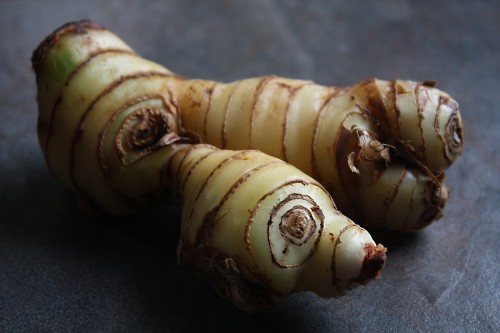The two are, in most cases, not interchangeable. In fact, hardly anyone who lives in Thailand where galangal (sometimes, galanga) grows like weed ever resorts to the powder version. The inferior galangal powder is useful when you live in a place where fresh galangal is not readily available.
There is, however, a limit to the extent to which galangal powder can be used instead of fresh galangal. In a dish where galangal is either optional or used so minimally such as Laab, galangal powder comes in handy. When minced galangal is used in a marinade, galangal powder also serves as a pretty good substitute. However, in a dish the success of which relies heavily on the use of fresh galangal, e.g. Tom Kha Gai, using galangal powder in lieu of fresh galangal, in my opinion, will result in tragedy in a bowl.
Fresh galangal is often prepared by being slice thinly crosswise. There’s no need to peel it. Thinly-sliced galangal is ready to be pounded together with other ingredients to make a curry paste or added to an infusion soup such as Tom Yam or Tom Kha Gai.
Fresh galangal, wrapped in a double layer of paper towel and put in a plastic bag, stay fresh in the vegetable crisper in the refrigerator for almost two weeks. It can be sliced thin and frozen for longer storage, but I don’t recommend it. This is because freezing alters the taste, aroma, and texture of fresh galangal quite a bit. Previously-frozen galangal, once thawed, becomes spongy in texture, tea-like in aroma, and a bit bitter in taste. It’s still usable in a curry paste, but detrimental to a dish like Tom Yam.











